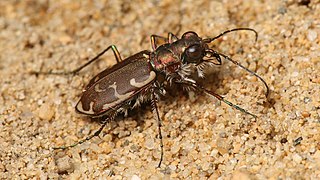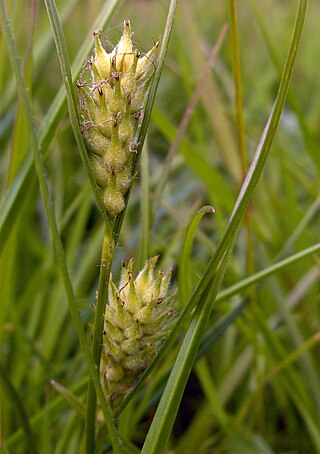
The Cyperaceae are a family of graminoid (grass-like), monocotyledonous flowering plants known as sedges. The family is large, with some 5,500 known species described in about 90 genera, the largest being the "true sedges" genus Carex with over 2,000 species.

Ornamental grasses are grasses grown as ornamental plants. Ornamental grasses are popular in many colder hardiness zones for their resilience to cold temperatures and aesthetic value throughout fall and winter seasons.

Carex is a vast genus of more than 2,000 species of grass-like plants in the family Cyperaceae, commonly known as sedges. Other members of the family Cyperaceae are also called sedges, however those of genus Carex may be called true sedges, and it is the most species-rich genus in the family. The study of Carex is known as caricology.
Yanal Bog is a 1.6 hectare biological Site of Special Scientific Interest on the southern edge of the North Somerset Levels, just north of the village of Sandford, North Somerset. It was notified as an SSSI in 1988.

Carex rostrata, the bottle sedge or beaked sedge, is a perennial species of sedge in the family Cyperaceae.

Cicindela repanda, commonly known as the bronzed tiger beetle or common shore tiger beetle, is a species of tiger beetle that measures 10–13 millimetres (0.39–0.51 in) long, lives in most of North America. Its labrum is small with one tooth and the pronotum is coppery and hairy. The shoulder marking touches or nearly touches the middle band. It is usually seen in spring and summer and it lives in sand, gravel, or clay soil. Its food is many insects and some fruit. The species have a two-year life cycle. It can be found all across sand dunes around the Great Lakes. The species comprises three subspecies: C. repanda repanda, C. repanda novascotiae, and C. repanda tanneri.

Mocis repanda, the striped grass looper, is a species of moth of the family Erebidae. It was described by Johan Christian Fabricius in 1794. It is found in Central America and the Caribbean, including Cuba, the Dominican Republic, Guadeloupe, Guatemala, Jamaica, Puerto Rico and Saint Thomas. Strays can be found in the United States, up to southern Texas as well as subtropical Africa south of the Sahara, including the islands of the Indian Ocean.

Bagisara repanda, the wavy lined mallow moth, is a moth of the family Noctuidae. The species was first described by Johan Christian Fabricius in 1793. It is found from the southern United States, south through Guatemala, Panama, the Antilles, Paraguay, Colombia, Venezuela, Guyana and Brazil to Argentina.

Carex riparia, the greater pond sedge, is a species of sedge found across Europe and Asia. It grows in a variety of wet habitats, and can be a dominant species in some swamps. It is Britain's largest Carex, growing up to 130 cm tall, with glaucous leaves up to 160 cm long. It hybridises with a number of other Carex species, including the closely related Carex acutiformis – the lesser pond sedge. A variegated cultivar is grown as an ornamental grass.

Carex hirta, the hairy sedge or hammer sedge, is a species of sedge native across Europe. It has characteristic hairy leaves and inflorescences, and is the type species of the genus Carex.

Carex binervis, the green-ribbed sedge, is a European species of sedge with an Atlantic distribution. It is found from Fennoscandia to the Iberian Peninsula, and occurs in heaths, moorland and other damp, acidic environments. It typically grows to a height of 15–120 cm (6–50 in), and has inflorescences comprising one male and several female spikes, each up to 45 mm (1.8 in) long. The utricles have two conspicuous green veins, which give rise to both the scientific name and the common name of the species. In the vegetative state, it closely resembles C. bigelowii, a species that usually grows at higher altitude. C. binervis was first described by James Edward Smith in 1800, and is classified in Carex sect. Spirostachyae; several hybrids with other Carex species are known.

Carex sect. Ovales is a section of the genus Carex, containing around 85 species of sedge. It is the most diverse section of the genus in North America, containing 72 species:

Carex subg. Carex is a subgenus of the sedge genus Carex. It is the largest of the four traditionally recognised subgenera, containing around 1400 of the 2000 species in the genus. Its members are characterised by the presence of one or more exclusively male (staminate) terminal spikes, quite dissimilar in appearance from the lateral female (pistillate) spikes below. In most species, the female flowers have three stigmas, but a few species, including Carex nigra, have female flowers with only two stigmas.

Lithophyllon repanda is a species of mushroom or disc coral in the family Fungiidae.This species is able to move to another location on occasion. The International Union for Conservation of Nature (IUCN) rated it as a least-concern species and it was originally described by Dana in 1846. It occurs at depths of 1 to 30 metres.

Carex subg. Vignea is a subgenus of the sedge genus Carex, containing around 300 of the 2000 species in the genus. Its members are characterised by having bisexual, sessile spikes, where the female flowers have two stigmas each.
Panopoda repanda, the orange panopoda, is a species of moth in the family Erebidae.

Boronia repanda, commonly known as the granite rose, repand boronia or border boronia, is a plant in the citrus family Rutaceae and is endemic to an area near the eastern border between New South Wales and Queensland in Australia. It is a small erect, woody shrub with many branches, thick warty, oblong leaves and pink, rarely white flowers arranged singly in leaf axils.

Carex viridula, known as little green sedge, green sedge, or greenish sedge, is a small flowering plant native to North America, Europe, Asia, and Morocco.













